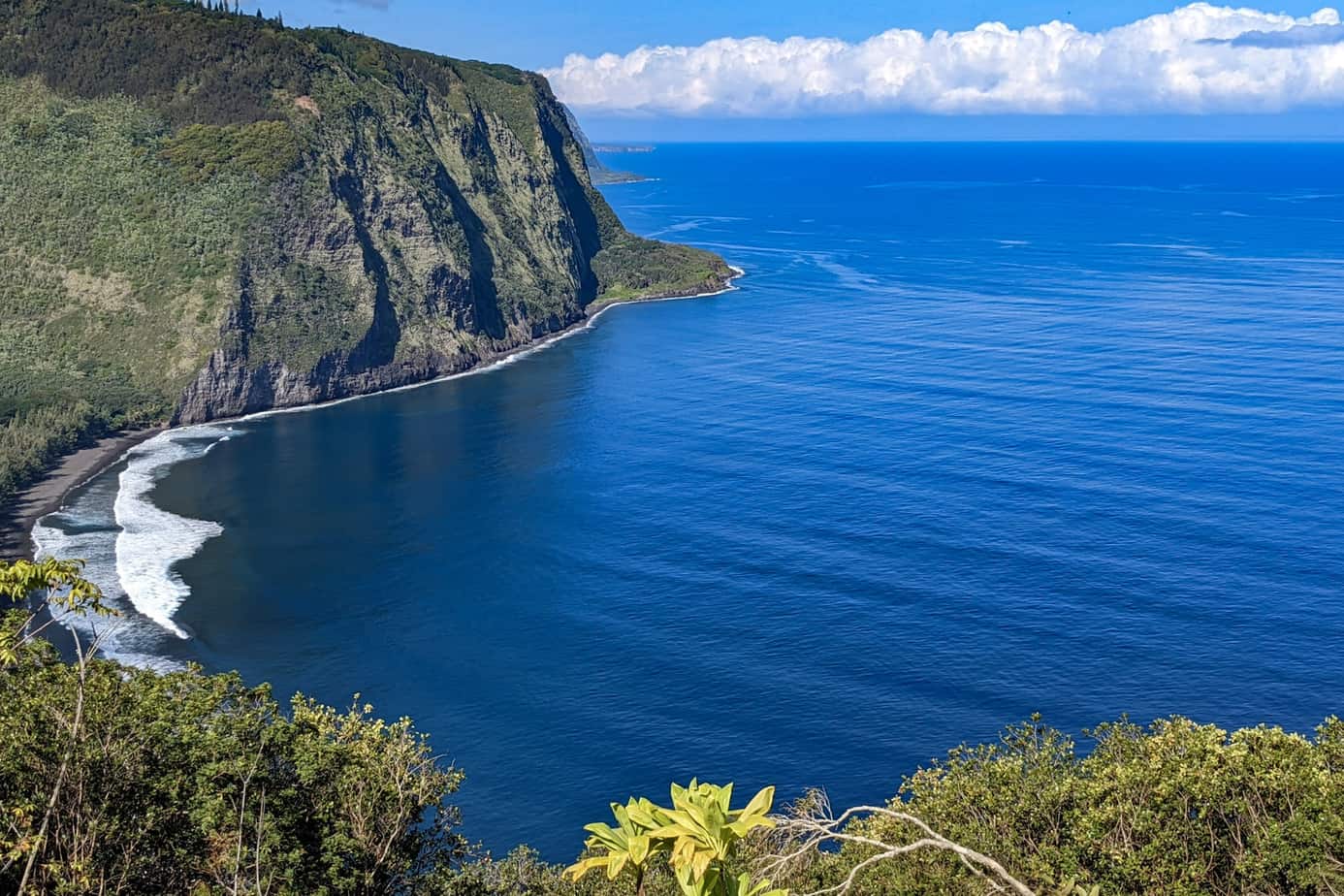5-Day Big Island Itinerary- 2024
Hawaii’s sun, warm water, exotic plants, and volcanic landscape make it an island paradise. After visiting all four of the main Hawaiian islands, The Big Island is my favorite. There is a perfect balance of adventure, sun, and culture. I didn’t get everything right on my trip and learned along the way. So, when you’re planning your trip to Hawaii this is how I’d spend 5 days on The Big Island (after doing it).
Some of the links on the page are affiliate links. If you choose to purchase from one of the links, I earn money at no extra cost to you. I’ll only recommend brands I’ve used and love (or an alternative I would book myself). As an Amazon Associate, I earn from qualifying purchases. I always pay for my own travel. I’ll be sure to let you know if that ever changes. If you choose to click through and purchase – thanks so much for the support!
5-Day Big Island Itinerary- The Overview
My itineraries never include travel days since it’s so variable. Adjust as you need to based on when you arrive and depart.
Day 1– Stay Waikoloa – Pololū Valley Lookout, Waipi’o Valley Overlook, Keokea Beach Park
Day 2– Stay Waikoloa- Snorkle, Farmers Market, Manta Ray Snorkle
Day 3– Stay Waikoloa- Beach Time, Coffee Plantation Optional: Mauna Kea Stargazing
Day 4-Stay Hilo, Explore the Jungle and Waterfalls, Volcanoes National Park Lava Viewing
Day 5- Volcanoes National Park
Day 1- Explore for the Views
The views on The Big Island are next level. There are green jungles, black lava rock, and the deepest blue-green oceans you can imagine.
And, you need one day to see all of the highlights! This is where your rental car will be useful.

Morning
Leave from Waikoloa or Kona and head to the Pololū Valley Lookout. There is limited parking here so be patient and respect the rules and locals.
Take a few pictures and take in the sites. In the winter you may see some whales breeching!
You can also hike down to a black sand beach from the lookout. The hike will take 20-30 minutes down. The elevation change is 480 ft. The terrain is tricky so bring poles and proper shoes. If it’s raining the trail is slick!
You can’t swim at the beach because the waters are too rough. So, the long trek down wasn’t it worth it for me.
I came for the views and then left!
If you’re needing a snack or a break swing by the Kēōkea Beach Park. You can’t swim here but there are shallow pools you can check out and you can take in the views at the tables or on the rocks.

Afternoon
Stop for Lunch in Waimea.
After lunch, head to the Waipiʻo Valley Lookout. The is trail here too but the road is closed to pedestrians and tourists. It’s not in good condition so only those who need to use the road are permitted to use it.
There is security there throughout the day to be sure no one drive down.
This is a sacred place for Hawaiian’s so please mind the rule. The view at the top is incredible on it’s own.
If you want to see the valley consider a horseback tour.
Day 2- Waikoloa
If you don’t have snorkel gear head to Snorkle Bob’s to rent from them.
It was affordable and really nice that you can rent on one island and turn them in on another if you need to. I’m not an affiliate for them or anything. But, they helped me figure out why my dive mask had been leaking for years. I’m a fan forever.
To be honest, I didn’t understand the appeal of snorkeling until Hawaii. So, even if you’re skeptical. Give it a go.
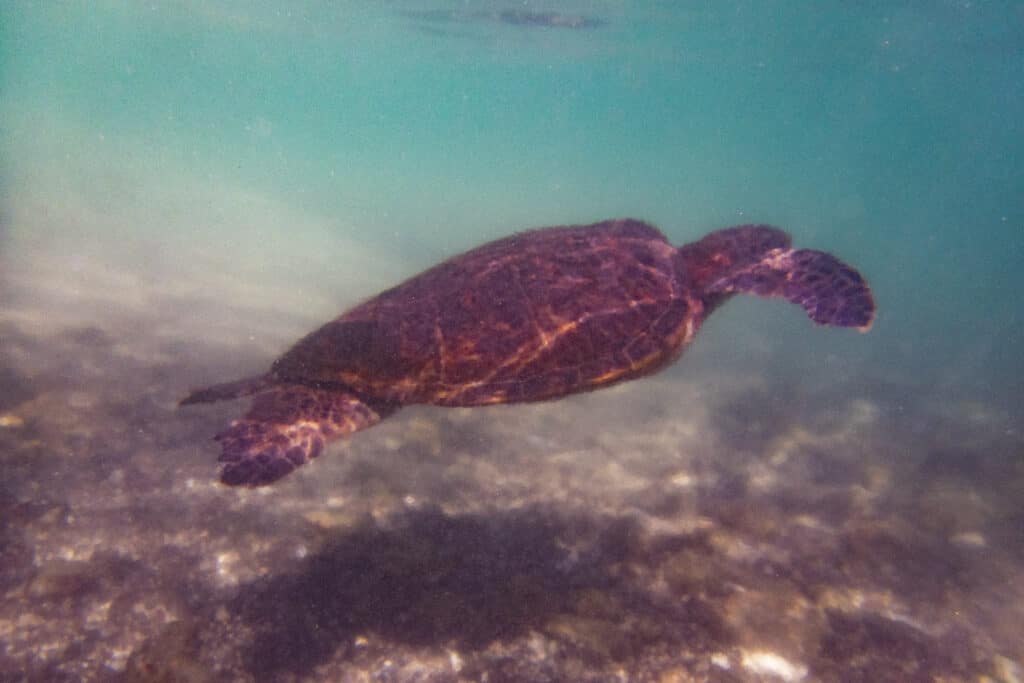
Morning
Start your day by snorkleing at the Hilton Waikoloa Village. This is much easier if you’re staying there but it isn’t necessarily required.
The bay the hilton is protected so it’s an easy snorkle even when the waters are rough. There is sea turtle that makes a regular (almost daily) appearance. Keep your eyes peeled to find her! There are also lots of colorful fish.
You can also see the dolphins at the rescue on the property.
The Kahaluʻu Beach Park is another beginner friendly snorkle site. It’s an easy entry to shallow and protected water. You’ll still see lots of fish and sea turtles are known to come here as well. If you want a good beginner spot closer to Kona this is a better pick than the Hilton.
You can also Snorkle at Captain Cook’s Monument. It’s the best snorkle option on the island. But, its a long hard hike. The down is fine it’s the coming back up! So, take a boat tour to snorkle here. Especially if you’re not a super experienced hiker or snorkler.
My Favorite Things I Took to Hawaii
- Be sure to use reef-safe sunscreen. This is my favorite.
- This waterproof camera is a perfect alternative to a go-pro when you’re snorkeling or diving.
- My Nikon Z5 is my go-to camera for all of my travels. It’s lightweight and water-sealed!
- If you get motion sick bring all of the things you need for water-based activities; motion sickness bands are a favorite of mine.
- My Fjallraven bag is my go-to day bag when I’m not hiking.
- This bag keeps your phone from getting wet when you’re near the water.
Afternoon
After your snorkling adventures takes some time to relax in the afternoon.
The island is known for having several farmer’s markets. These are produce and craft markets. Shop for some souvenirs or try local fruits.
Lilikoi (passion fruit) and the apple bananas are my favorites.
Search for the times/days here.

Evening
There aren’t always evening portions to my itineraries. But, in an effort to only have to deal with sea salty hair once, schedule a tour to swim with the manta rays.
This was one of the most incredible experiences I’ve ever had. It is also very accessible if you’re on The Big Island.
If you do one thing from my itinerary, swimming with manta rays should be it. No question.
Seriously, I recommended this to a local Big Islander who had never done it. I heard back that they went and loved it!
Several years ago, a hotel on a waterfront wanted guests to be able to see waves crashing against the cliffs at night. So, they set up lights on their property. Later, they realized the lights attract plankton, and manta rays come in to eat the plankton.
That boat ride is almost nothing because the mantas swim toward the hotel’s lights by the shore. The company provides a wet suit to help you float (and keep you warm in winter).
There is a specially-made floating platform with lights on it. You’ll hold on to the platform and have a pool noodle under your feet to keep your feet floating.
As you’re floating, the mantas will start to come to eat dinner. They have no concept of space. You’ll have mantas consistently coming centimeters from your face and body.

Day 3- Beach Time and Tour A Coffee Plantation
Morning
One of the best beaches on The Big Island is at the Mauna Lani Beach Club. Even though it’s at the hotel every beach is public in Hawaii. The catch here is that the parking is limited. There are limited parking permits given out on a first-come-first-serve basis.
So, get there early. By 8:00 a.m. there were already other cars there.
But the beach is incredible and the snorkling is too. It’s a great way to spend a morning in Hawaii.

Afternoon
Clean up and eat lunch in Kona.
I love Foster’s Kitchen personally but there are others options (even for gluten-free).
After lunch head out to tour a coffee plantation. Kona coffee is a big deal; and it really is good coffee.
There are tons of options for your visit but you should book your tour early to be sure you can go where you want.
I can recommend the Heavenly Hawaiian Coffee Farm.
They are a small operation with some of the best coffee I’ve ever tasted. The tours are small, and you should be before you show up.
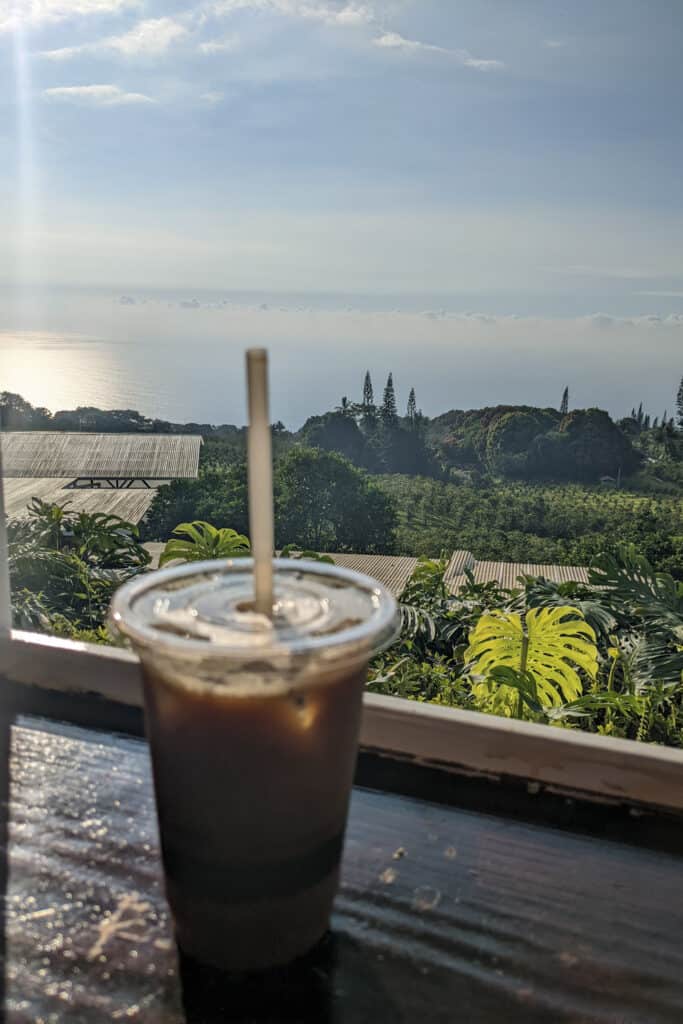
You’ll see the coffee trees and learn about the growing, picking, drying, and roasting processes. Learn about the different types of coffee and how to judge a good cup of coffee. They are very knowledgeable and super friendly.
Evening Option
Mauna Kea is home to some of the best star gazing in the world.
It’s at the top of the volcano though so it can be cold and hard to get too.
You’ll want to take a tour unless you packed warm clothes and rented a 4-wheel drive vehicle. But, you can see the sunset and the stars from one of the best places in the world!
Day 4- Hilo, Waterfalls, and Lava
Morning
Drive to Hilo and start chasing waterfalls. Akaka Falls and Rainbow Falls are a great place to start
Stop at Akaka Falls on your way into Hilo. The waterfall is 25 minutes north of Hilo in a state park.
The state park is open from 8:00 am-5:00 pm. You’ll pay $10 per vehicle for parking and $5 per person for admission.
The hike is under a half-mile. However, it does require descending some stairs and ascending an incline. The view of the waterfall is worth it.
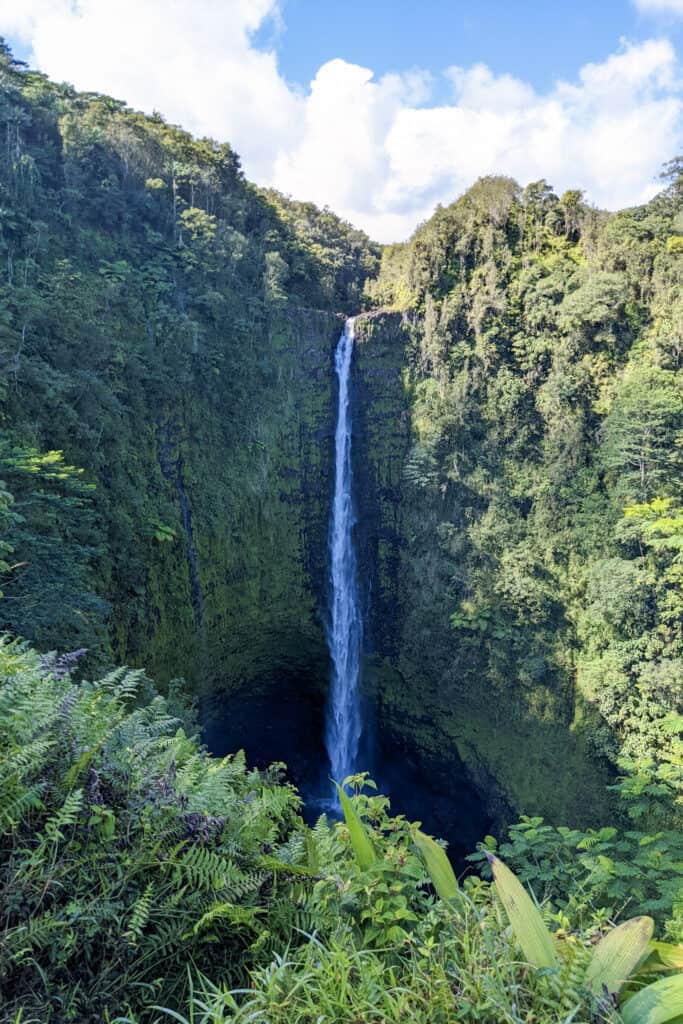
This is a really popular waterfall. The parking lot will be busy and so will the trail unless you arrive very early.
Even with the crowds it was a good experience. You can still see the waterfall clearly and people were genearlly patient.
Rainbow Falls is pretty much in Hilo and is a short walk for a great view. It’s also at a park so there are picnic tables and restrooms.
To see the rainbow you’d have to get there early in the morning when the light is right.
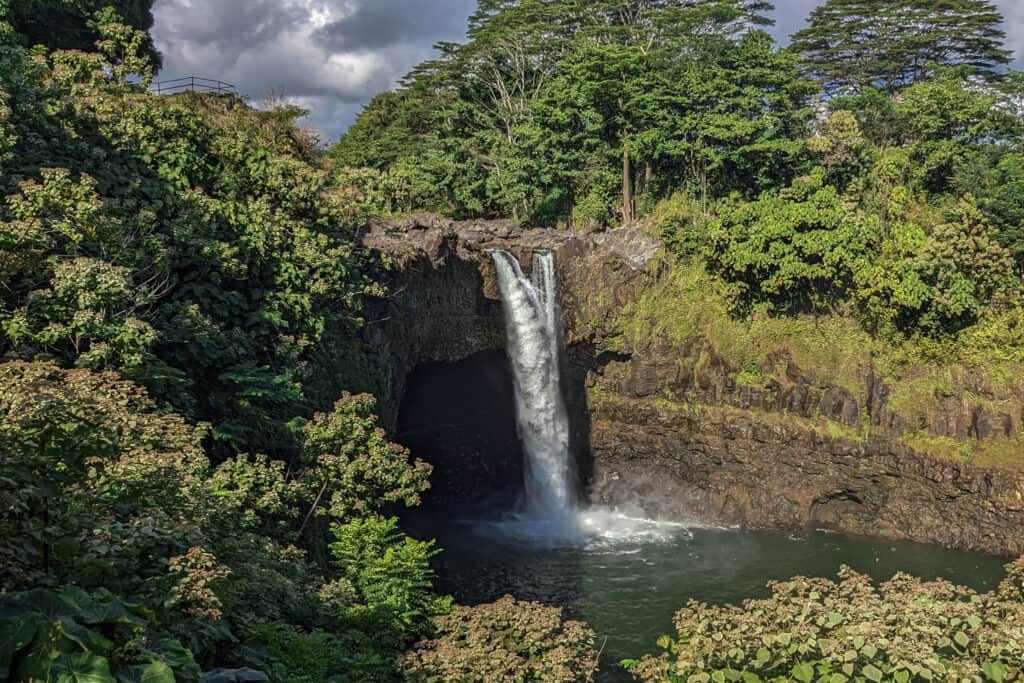
Afternoon
Head to Hilo and check into your hotel.
If you have time wander around downtown Hilo. There is a Japanese inspired park down town that is relaxing to walk through.
Rest because tonight will be a late night.

Evening- Lava Viewing
Even though the volcano in the park is pretty active, you aren’t guaranteed to see lava.
The volcano has a mind of its own. Even if it has been erupting, it can spontaneously decide to take a break for a couple of days.
Check the park webcam and/or check in with park rangers at the visitor station for the best information.
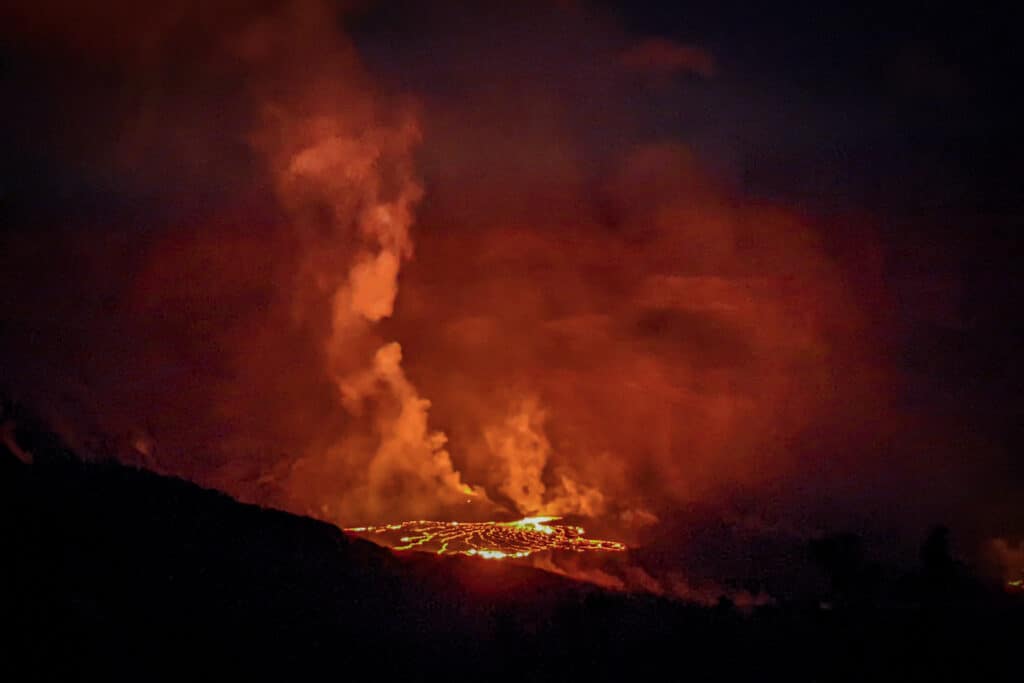
If it’s flowing, you will see the lava lake/eruption clearly after dark. So, after dinner, head into the park with your head lamp/flashlight to see the lava.
Most people won’t stay in Hilo, so they have to exit early to drive the 2 hours back to Kona. If you headinto the park around 9:30 p.m. they’ll be leaving and the crowds/parking will be easier to navigate.
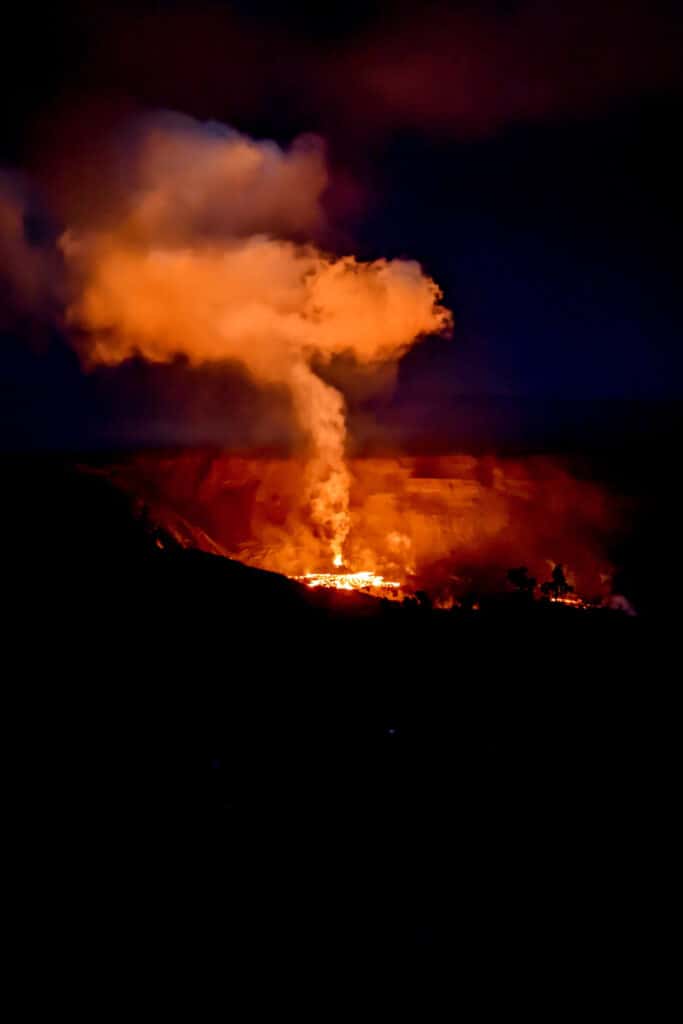
It may be a hike to see the lave. You could be walking on roads damaged by volcanic activity and then down a trail with some large rocks.
Once our eyes adjusted, it was no big deal, but headlamps would have been helpful.
Wear warm clothes for the lava viewing. It gets chilly up on the mountain at night.
Day 5- Volcanoes National Park
Volcanoes National Park was one of the most incredible places I’ve ever visited. S
tart early today and pack your lunch because you’ll spend the whole day in Volcanoes.
One of my favorite things about Volcanoes (and Haleakala) is that they honor the native culture. It’s just worked in, and keeping the original stewards and keepers of the land in mind is important.

The park is 45 minutes from Hilo and 2 hours from Kona. You’ll lose a lot of park time driving if you try to stay on the Kona side of the island.
The fee to enter the park is $30 per vehicle for one week. A pass to all of the national parks is $80.
Consider the annual pass if you plan to visit more than one national park within a calendar year.
It can be chillier at the top of the mountain than in other parts of the island. Consider bringing warmer clothing to be comfortable.
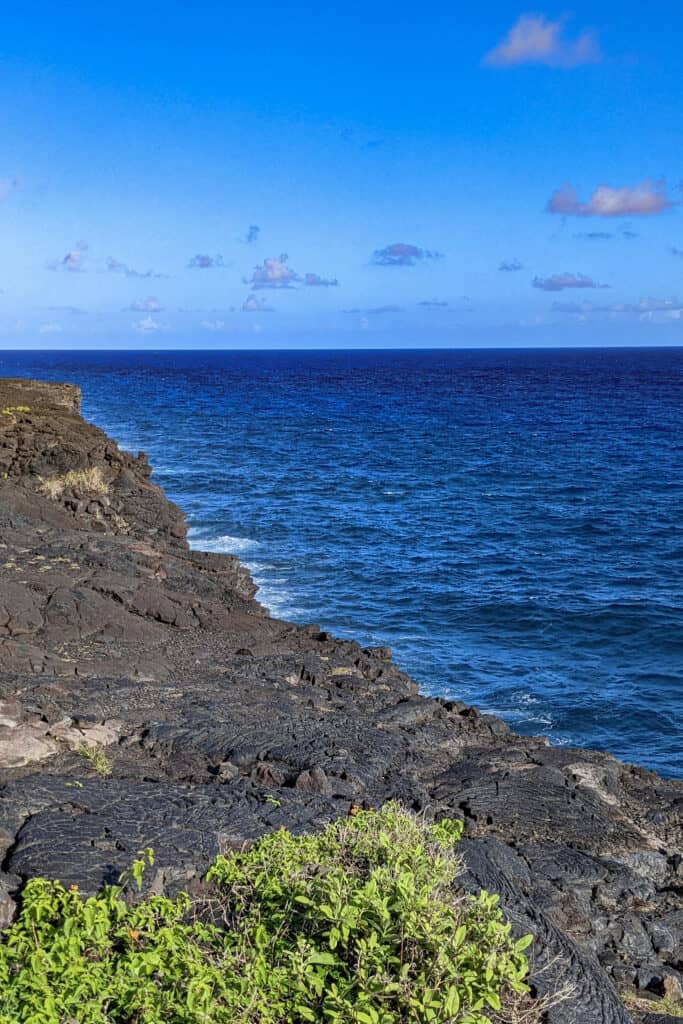
Drive Chain of Craters Road and Stop at Overlooks
Chain of Craters road takes you through most of the park. Plan to spend 3 hours on this 18-mile drive. There is no food, water, or fuel on the drive.
The eruption in 2018 actually went over this road and is now much shorter than it used to be. You can park and walk to the hardened 2018 lava flow at the end of the road if you’d like.
There are several places along the road you’ll want to stop.
- Puhimau Crater and Pauahi Crater – overlook deep craters that give the road its name.
- Mau Loa o Maunaulu – you can’t miss these vast lava fields. You’ll feel like you’ve driven to another planet. Be sure to get out and explore
- Kealakomo Overlook– Even if you don’t stop at this specific lookout, you’ll stop along the way to see the lava flowing into the ocean, one of the picturesque scenes in the park.
- Hōlei Sea Arch-Park your car at the end of the road. Follow the road, and the crowds, down a bit, and you’ll see the viewing area for the sea arch on your right. Just be mindful when you’re climbing and walking on the lava rocks. They can be loose, and they are sharp if you happen to fall accidentally.

Hike
There are many options for day hikes in the park. Plan your time accordingly. The drive can take a while, and it’s easy to plan too much for your day.
Crater Rim Trail
This hike is excellent to get you along the edge of the massive crater. Look for the steam from the lava pit or stand next to steam vents and feel how hot the air is. It will take you by surprise! This area changed a great deal with the eruption in 2018.
Find the pictures of the site before and after. It’s remarkable how quickly it changed.
This is an easy trail and the length can vary.
It’s accessible from several parking lots along Crater Rim Drive, so you can walk all or part of it. It’s worth it to get out of the car and walk this trail, even if you walk it in pieces. This is also a trail that would be good for biking.
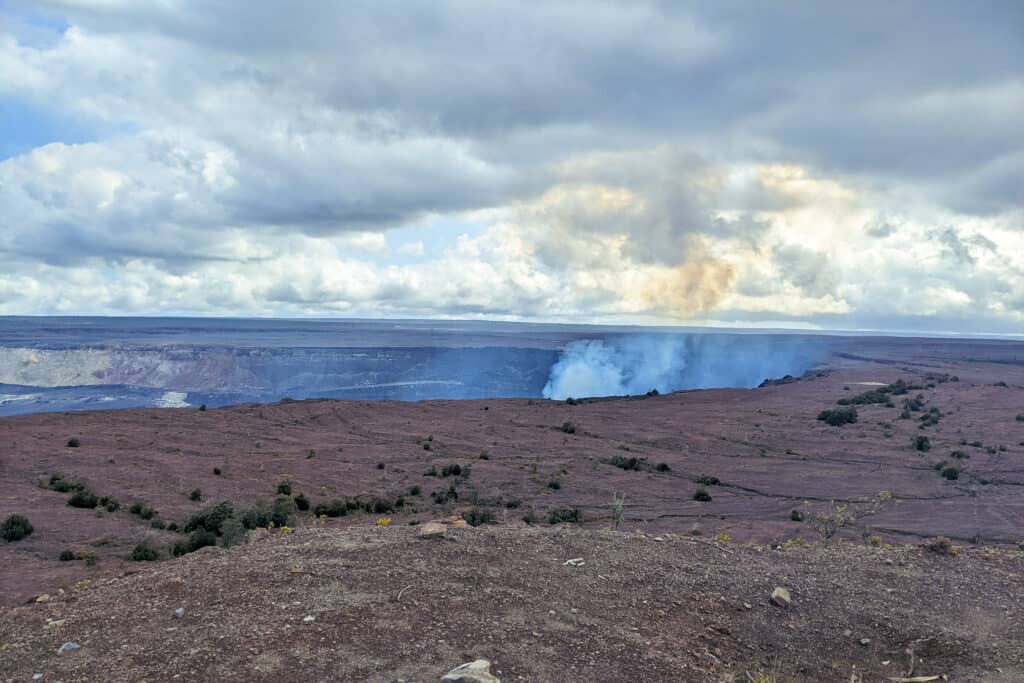
Nāhuku (Thurston Lava Tube)
This is possibly the most popular hike in the park, or maybe there is just so little parking that it makes it feel that way. Start this hike before 9 am or 4 pm to have the best chance of nabbing a parking spot. Otherwise, plan to be patient.
Park at the Kīlauea Iki Overlook to make this a 1.5-mile hike. Most of the walk is through a 500-year-old lava tube. Wear sturdy footwear. The tunnel is lit between 8 am and 8 pm. Bring a flashlight/headlamp if you’re hiking during off-hours.
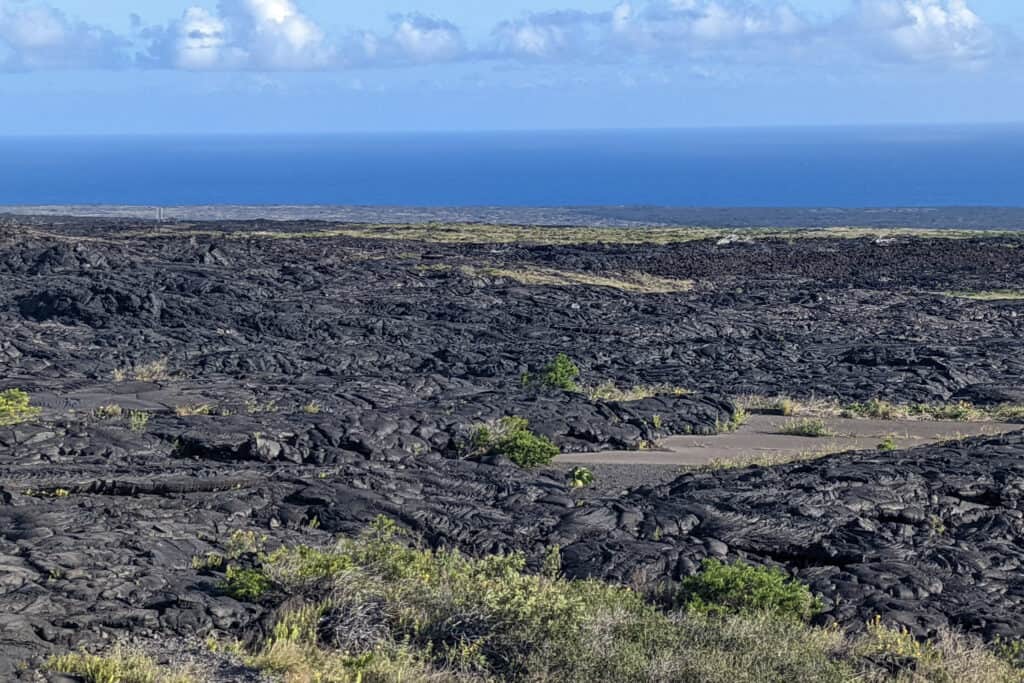
About The Big Island
The Big Island is the largest of the Hawaiian Islands. Rent a car to make sure you can see everything.
The Big Island is the youngest of the islands, which is why there is so much prominent lava and volcanic impact on the island. This also means you will find lava rock and lava cliff seashores, not the white sand beaches you’re probably expecting.
The Kona Ironman Race is held on the big island. There are large shoulders on the roads for athletes to train in preparation for the big race.
There are two main cities. Kailua-Kona on the island’s west side and Hilo on the island’s north side. Both cities have airports.
Kailua-Kona and the neighboring resort city of Waikoloa Village are the most popular among tourists. This is where you’ll find the large resorts. This is also the side of the island known for better weather.
Hilo is on the rainforest side, so it gets more rain than the Kailua-Kona side. It is closer to the national park and is home to the big waterfalls.
It is also the side most locals live on and can be a cheaper place to stay on the island.
The Hilo side of the island is the side that had the fissure and lava flow impact in 2018.
Where to stay
Plan to spend some time on each side of the island. You’ll be tempted to spend your whole trip on the Kailua-Kona side.
That would be a mistake.
The Hilo side has so much worth experiencing, and it is much easier to visit Volcanoes National Park from the Hilo side.
The Hilton Waikoloa Village is a large resort on the island’s west side. The property is enormous, and we snorkeled with sea turtles in the bay on the property.
The SCP Hilo Hotel is an exceptional hotel on the Hilo side. They give back to the community. From an eco-travel perspective, Hawaii is miles above the rest of the US when it comes to considering the travel industry’s impact.
But this is one of my favorite hotels; it just takes being conscious to a new level. They also have kombucha on tap, and that is something that makes my hippie heart very happy!
Other Things to Consider Doing on The Big Island
Drive the Perimeter and Belt Road
The landscape on each part of the island is unique. Plan to drive as much of the perimeter of the island as you can.
This would be about 5 hours of driving, so you won’t want to do it one day. Trip to plan your trip from Kona to Hilo on one way and Hilo to Kona on the other.
The Belt Road connects Hilo and Kona. It shortens the travel time between the two, and the landscape mesmerizes. You can even tell where lava flowed over the road at one point.The best I could do without a zoom lens.
Blackwater Dive
Kona is home to the original blackwater dive. You’ll hop on a boat and head to a specific area a few minutes out. This is where the creatures that typically live deep come up toward the surface at night.
The boat right isn’t a long one, so that’s always nice if you struggle with motion sickness.
You’ll be attached to a line coming and only need your open water certification.
Most outfits do require that you’ve done 20-25 dives before you can go on this one.
The dive isn’t an option every day, so you may have to plan your trip around it.
Colored Sand Beaches
Black sand and green sand beaches are very cool to see.
Punaluu Beach is a black sand beach that is relatively easy to access. It’s about halfway between Hilo and Kona. Consider seeing it as you drive the perimeter road.
Papakolea Beach is on the southern point of the Big Island. This green sand beach is like nothing you’ve ever seen before.
But, it is also only accessible by hiking for several miles or taking an offroad vehicle. If you don’t want to do the hike, locals will likely be offering rides in their truck beds for a fee. Don’t plan to swim at this beach, as the surf can be intense, but the fierce green hue of the sand makes for a unique experience.
Hāpuna beach is near Waikoloa. All beaches are publicly accessible in Hawaii, so even though this beautiful white sand beach is at a hotel, there are some free public parking spots. G
o early in the day to make sure you can get a parking spot.
By 9:30 a.m. it’s already pretty full. The beach is excellent for relaxing, and on calm days you can snorkel along the cliffs on either side of the semi-protected bay.
Adventuring on the Big Island
There is so much to do on your visit to the Big Island! The beaches aren’t as pristine as those on Maui, but there is so much more to do! Keep yourself busy and have some great experiences!
Let me know what else you love so I can add it to our list next time we visit The Big Island!
How many days do you need to see the Big Island?
5-7 days on the Big Island gives you time to see the main sites and not feel extremely rushed. The Big Island is big. It takes much longer to drive from place to place than it does on other islands.
What should I not miss on the Big Island?
There are so many things you have to see on the Big Island. Volcanoes National Park, snorkeling, a night snorkel with manta rays, Waip’io valley, a Kona coffee farm, and star gazing on Mauna Kea are great places to start!
Is there a lot to do on the Big Island?
Yes! There is so much to do. You can see waterfalls and beautiful landscapes, snorkel with manta rays, visit Volcanoes National Park and hopefully see some flowing lava, or go star gazing on Mauna Kea. The Big Island is a great location if you want some adventure and some relaxation.
Do I need a car on the Big Island?
Yes. The Big Island is big and the best way to see it is to drive yourself.
If that isn’t an option you can get by with tours but it won’t be as fun.
What is the prettiest part of the Big Island?
All of it. The landscape of the Big Island is unlike anywhere else. No matter where you are you’ll be surrounded by beautiful, unique landscapes.
Is it better to go to Hilo or Kona?
It’s best to go to both Hilo and Kona if you can. Kona will likely have warmer weather and is home to beaches. But, Hilo is closer to Volcanoes National Park, and staying in Hilo affords you more time to explore. Also, the waterfalls are on the Hilo side of the island.
Can you swim on the beaches of the Big Island?
Some of them. Hapuna Beach is the most popular for swimming. The currents and cliffs on the Big Island can make swimming difficult or dangerous.
What airport do I fly into for the Big Island?
You can fly into Kona-Kailua (KOA) or Hilo (ITO) airports.
Is 3 days in Big Island enough?
3 days is better than zero days but you’ll be limited in what you can do. Be sure to have a plan and know what you want to see!
